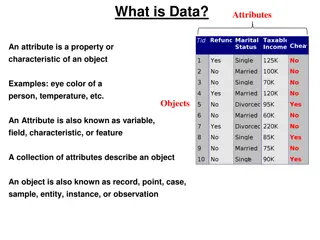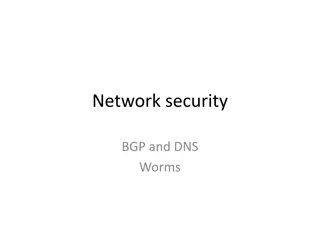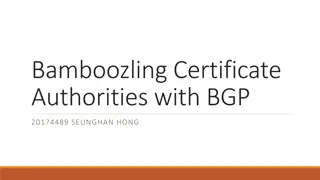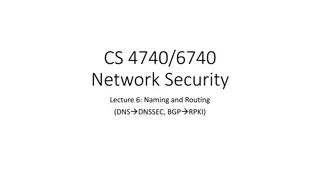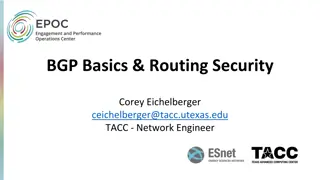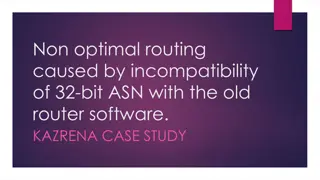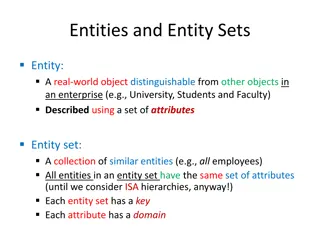
Optimizing BGP Route Selection for Efficient Interdomain Routing
Explore the intricacies of BGP attributes and route selection strategies for maximizing network performance. Learn about AS_PATH manipulation, best path criteria, and the factors influencing BGP route advertisements between autonomous systems. Gain insights from a hands-on tutorial at the University of South Carolina's Engagement and Performance Operations Center.
Download Presentation

Please find below an Image/Link to download the presentation.
The content on the website is provided AS IS for your information and personal use only. It may not be sold, licensed, or shared on other websites without obtaining consent from the author. If you encounter any issues during the download, it is possible that the publisher has removed the file from their server.
You are allowed to download the files provided on this website for personal or commercial use, subject to the condition that they are used lawfully. All files are the property of their respective owners.
The content on the website is provided AS IS for your information and personal use only. It may not be sold, licensed, or shared on other websites without obtaining consent from the author.
E N D
Presentation Transcript
A Hands-on Tutorial on BGP University of South Carolina (USC) Engagement and Performance Operations Center (EPOC) Internet2 Technology Exchange December 9, 2024 1
BGP Best Path The main goal is to provide interdomain routing BGP selects one path as the best path It places the selected path in its routing table and propagates the path to its neighbors Is this the best path? Does it meet the path selection criteria? If so, add to routing table. BGP Update BGP Table Routing Table Network Network Rick Graziani, Implementing Cisco IP Routing, Cisco Press, 2015 3
BGP Route Advertisements between ASs In BGP route advertisements, each border router prepends its own AS number to the route before advertising the route to the next AS AS 100 AS 200 AS 300 AS 400 r1 r2 r3 r4 AS_PATH : {100} AS_PATH : {200,100} AS_PATH : {300,200,100} 4
BGP Best Path 1. 2. 3. Prefer the path with highestweight(configured locally; set to 0 (default) for routes not originated by the router) If weights are the same, prefer the path with highestlocal preference(set to 100 by default) If the local preferences are the same, prefer the path that was originated by BGP running on the router or redistributedfroman InteriorGatewayProtocol(IGP) If no route was originated, prefer the path with the shortestAS_PATH If the paths have the same AS_PATH length, prefer the path with the lowest origin type (IGP is lower than Exterior Gateway Protocol (EGP), and EGP is lower than Incomplete) If the origin codes are the same, prefer the path with the lowestMED attribute(set to 0 by default) If the paths have the same MED,prefer the Externalpath(EBGP) over the Internal path(IBGP) If the paths are still the same, prefer the path through the closest IGP neighbor(lowestIGP metric) If both paths are external, prefer the path that wasreceivedfirst (oldest one) If the paths are still the same, prefer the path from the BGP routerwith the lowestrouterID If the router ID is the same for multiple paths, prefer the path with the lowestIP address 4. 5. 6. 7. 8. 9. 10. 11. Rick Graziani, Implementing Cisco IP Routing, Cisco Press, 2015 5
BGP Best Path Without route manipulation, the most common reason for path selection is Step 4 Prefer the path with the shortest AS_PATH If multiple paths have the same length, the second most common decision point is Step 7 If the paths have the same MED, prefer EBGP over internal IBGP We sometimes refer to this as hot potato routing The network administrator can manipulate the local preference to change the outbound path, and the MED attribute for the inbound path Rick Graziani, Implementing Cisco IP Routing, Cisco Press, 2015 6
Local Preference Attribute For Outbound Route A well-known discretionary attribute Indicates to routers inthe AS which path is preferred to exit the AS (higher is better) Configured on a router Exchanged only among routers within the same AS (passed only via IBGP, not via EBGP) Default value on a Cisco/FRR router is 100 Local Preference takes precedence over AS_PATH This is very frequently used in provider networks Rick Graziani, Implementing Cisco IP Routing, Cisco Press, 2015 7
Local Preference Attribute For Outbound Route A well-known discretionary attribute Indicates to routers inthe AS which path is preferred to exit the AS (higher is better) Configured on a router Exchanged only among routers within the same AS (passed only via IBGP, not via EBGP) Default value on a Cisco/FRR router is 100 Local Preference takes precedence over AS_PATH This is very frequently used in provider networks All traffic in AS 64520 to 172.16.0.0 is sent via router A Rick Graziani, Implementing Cisco IP Routing, Cisco Press, 2015 8
The Med Attribute For Inbound Route Multi-Exit Discriminator (MED), also called metric Indicates to external neighbors the preferred path into an AS By default, a router compares MED for paths from neighbors inthe same AS (lowest is better) MED is sent to EBGP peers: Those routers propagate the MED within their AS, but do not pass it on to the next AS This may, or may not, be honored by the neighboring AS Rick Graziani, Implementing Cisco IP Routing, Cisco Press, 2015 9
The Med Attribute For Inbound Route Router B has set the MED to 150 for 172.20.0.0 Router C has set the MED to 200 for 172.20.0.0 Router A receives EBGP updates from routers B and C Router A selects router B as the best next hop to get to 172.20.0.0 because of the lower MED Rick Graziani, Implementing Cisco IP Routing, Cisco Press, 2015 10
Next-hop Attribute A well-known mandatory attribute Unlike IGPs, BGP routes AS by AS, not router by router The next-hop address for a network from another AS is an IP address of the entry point of the next AS along the path to that destinationnetwork This default behavior is sometimes overridden through an iBGP export/outbound policy known as next-hop self BGP table router r1 Rick Graziani, Implementing Cisco IP Routing, Cisco Press, 2015 11
The AS-Path Attribute Well-known mandatory attribute Whenever a route update passes through an AS, the AS number is prepended to that update Router A: advertises network 192.168.1.0 in AS 64520 Router C: prepends its own AS number to it and advertises the route to Router B Router B: the path to reach 192.168.1.0 is: 65500, 64520 Rick Graziani, Implementing Cisco IP Routing, Cisco Press, 2015 12
Origin Attribute A well-known mandatory attribute Defines the origin of the path information The origin attribute can be one of three values: IGP ( i ) The route is interior to the originating AS Normally when the network command is used EGP ( e ) The route is learned via EGP EGP is legacy and no longer supported Incomplete ( ? ) The route s origin is unknown / some other means It usually occurs when a route is redistributed into BGP BGP table router r1 Rick Graziani, Implementing Cisco IP Routing, Cisco Press, 2015 14
Administrative Distance A router may run multiple routingprotocols / static routes If BGP and OSPF are configured on a router, both protocols may provide different best paths (analogous to google-maps and mapquest) How does the router know which protocol to choose? The route with lower Administrative Distance is installed in the routing table Rick Graziani, Implementing Cisco IP Routing, Cisco Press, 2015 15
The Weight Attribute - For Outbound Route Configured locally and not propagated to any other routers (higher is better) This is a vendor-specific attribute Cisco supports it Juniper has a different mechanism to achieve a similar result Weight takes precedence over Local Preference Value from 0 to 65535; default is 32768 Default is 0 for routes not originated by this router Rick Graziani, Implementing Cisco IP Routing, Cisco Press, 2015 16
The Weight Attribute - For Outbound Route Router A has two ways to reach 172.20.0.0 via Router B (AS 65000) via Router C (AS 65500) Router A is configured to set the weight of updates coming from: Router B to 200 Router C to 150 Weight for Router B is higher, so Router A uses Router B as a next hop to reach 172.20.0.0 Rick Graziani, Implementing Cisco IP Routing, Cisco Press, 2015 17
BGP Table Internal version number of the table This number is incremented whenever the table changes 18
Status Code Code Meaning Displayed at the beginning of each line in the table s Table entry is suppressed d Table entry is dampened h Table entry history * Table entry is valid > Table entry is the best entry to use for this network i Table entry was learned via an internal BGP session r Table entry is a RIB-failure S Table entry is stale = Table entry has multipath to use for this network b Table entry has a backup path to use for this network x The table entry has a best external route to use for this network 19



